5-Out Motion and Single Gap Spacing Issues
I received a question recently that asked, "Do you find that 5 out motion ends up with a lot of single gaps(which aren't advisable to drive through)?"
Ultimately, this question is asking this. Do you have spacing issues for dribble penetration with the 5-out offense? And it's a fair question.
I've played in and coached a 5-out offense for nearly 25 years. The short answer is no...
However, it does depend on the level of basketball and how offense is taught. I think the potential spacing issues are less prevalent in youth and high school basketball. At the college and professional levels, it could be different due to better defense via experience, length, and athleticism.
With that being said, even at the college and professional levels, I think the issues are more related to poor offensive execution rather than specifically the 5-out offense. That's why you've seen the record-setting offenses of the Golden State Warriors and Dallas Mavericks use a 5-out offense at times.
We're going to break this down below, so you get a better understanding.
First, what is a single gap?
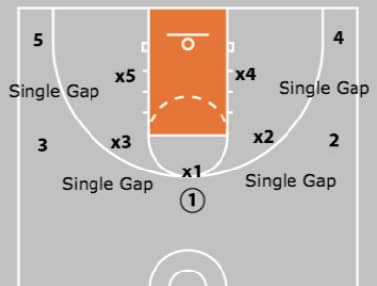
A single gap is when a defender is approximately one pass away. You will notice in a STATIC or STATIONARY 5-out motion, single gaps are everywhere.
In theory, the logic is that since there is less space between the help defense and the ball handler, it is easier to help on dribble penetration. This makes it easier for the help defense to stop you or swipe the ball away.
Obviously, you will have more success if you attack areas that have more space.
This is one of the genius aspects of "attack opposite of the pass" in the Attack & Counter Skill Development created by Don Kelbick. Naturally, there is more space and fewer defenders away from the pass.
What is a double gap?
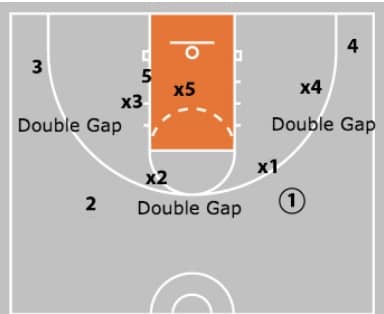
A double gap is when the next defender is two passes away. In theory, there is more space to attack which leads to more success.
With proper spacing in the 4-out and 3-out, you naturally have more double gaps.
This is a big reason that the Dribble Drive Offense has the wings near the corner.
Double gaps can be created with cutting, screening, and spacing. You might even overload one side of the floor, so you have more double gaps on the ball side. The NBA is known for isolation plays (ISOs) that try to accomplish the same thing.
However, with poor spacing, you can still have single gap issues no matter the offense.
Potential single gap issues in 5-Out and solutions
First off, I think this needs to be stated.
If you can develop skilled players, teach them how to play, develop an "attack" mentality, and teach them how to counter defenses, you're going to have success no matter what offense you run.
However, here are the potential issues you could face.
Issue #1 - The 5-out creates single gap spacing issues
Single gaps do occur in the 5-out offense as diagrammed above. They occur in all offenses.
However, are they more prevalent in 5-out offenses and does this cause issues?
I believe in a well-taught 5-out offense that double gaps should constantly appear for dribble penetration and cutting.
If your players are stationary and static with only single gap availability, you're teaching the offense differently than I would.
Players should be cutting, screening, and in constant motion while maintaining space.
Even when you're initiating your offense, it should be starting with a cut, ball screen, back screen, down screen, flex screen, or some other movement.
You should not stay in a static 5-out set. You shouldn't stay in a static anything.
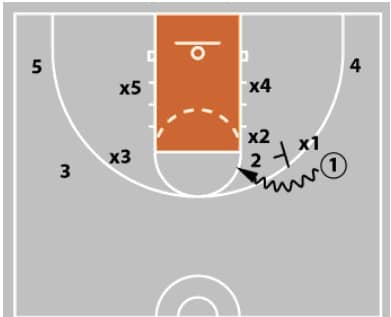
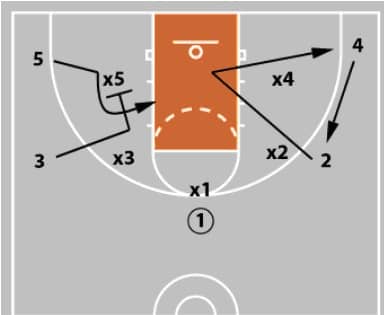
Issue #2 - It's easier for perimeter defenders to steal the pass
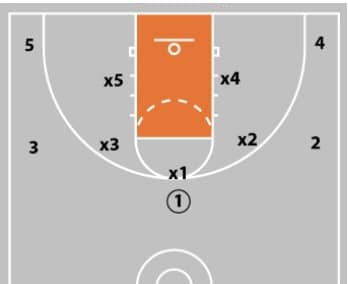
This is true if you don't follow the offensive advice above.
If you look at a diagram, it appears that the defender is closer to the ball and can steal more passes.
With our teams, we never let the offensive players remain stationary on the perimeter.
If you're overplayed, MOVE!
The options will vary based on the age level. As diagrammed above, you can...
- Cut backdoor
- Screen the ball
- Set a down screen.
- Use multiple actions such as a backdoor cut followed with a back screen or flex screen for a perimeter player.
With our youth players, we don't want them cutting beyond one big step beyond the 3-point line. If you don't get the ball, MOVE!
With our high school players, we have extended that to 25 to 30 feet.
Issue #3 - It's easier for help defense to provide quick help and quick recovery
Once again, this would be true if your team played from a 5-out stationary position
I found that one of the best times to dribble penetrate was when the player next to you cut to the basket, screened away, or even set a ball screen for you.
These actions create a lot of space to attack and preoccupies help defenders. It's difficult to defend a cut or screen while helping on dribble penetration.
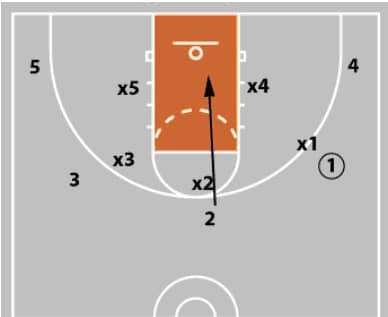
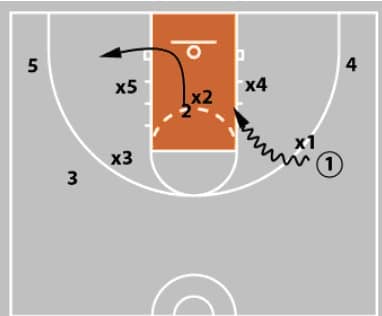
Issue #4 - It's easier to defend the backdoor cut against the 5-out
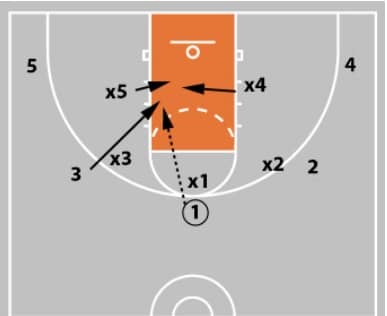
The theory is that the bottom helpside defenders can slide over to help on backdoor cuts.
First off, I think this is much easier said than done. Teams tried to do this against our teams.
It's so difficult in fact that almost all of the teams abandoned this approach. During my high school playing career, almost all of the teams switched to zone defenses. Most of them played 3-2 zone defenses, since we were a short team and didn't have a post player.
1 - The player is catching the ball 3 to 7 feet from the basket. Have you looked at the analytics on shooting the ball from this distance?
It's a high percentage shot even if you're closely guarded.

2 - There are more offensive rebounders on the weak side than defensive players.
If x2 doesn't drop down, 4 is wide open for the rebound, a pass, or lob. They might even stay put for a 3-point shot in the corner.
If x2 drops down to defender 4, 4 has a better chance to gain inside position for the offensive rebound.
X2 has to turn and run. 4 is already facing the basket and can just run straight in.
If x2 is quick enough, then you leave 2 or 1 open based on defensive rotations.
Pass-pass or pass-pass-pass will create a wide open shot or dribble drive opportunity.
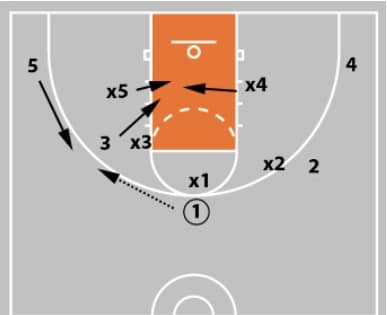
3 - The defensive rotation for x5 to help defend the basket cut is much easier diagrammed than executed.
The offensive player 5 will be cutting towards the wing at the same time that 3 cuts to the basket. So if the x5 defender slides over too much to help, 5 will get open perimeter jump shots the whole game.
And if 1 adds a simple pass fake to 3, this will create even more space for 5.
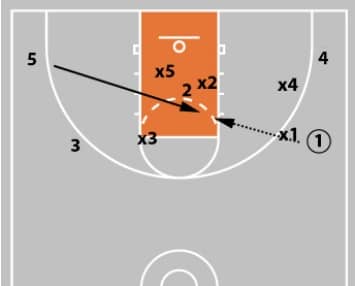
4 - Also, if you see the help defender cheating on the helpside cut, there are simple counters.
First, it's probably a good idea to have your player with the ball pass fake to the cutter to draw the helpside defense further out of position. Then you can...
Have the corner player blast cut to the mid-post area.
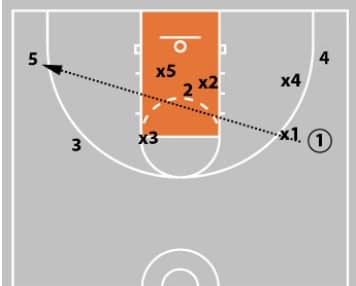
Throw a skip pass.
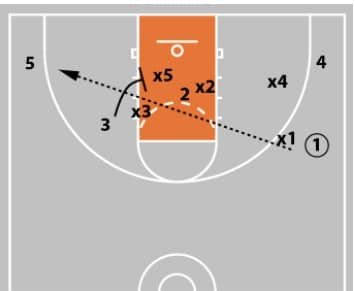
Use the wing player to set a pin screen and create a bigger advantage.
Am I Obsessed With the 5-Out Offense?
Not really. However, I am obsessed with teaching players universal offensive concepts and developing high IQ players.
At the youth and high school level, it doesn't matter to me whether you start from a 3-out, 4-out, or 5-out as long as you teach universal offensive concepts. That way, they can beat anything the defense throws at them.
In fact, for many offensive possessions, many only start from the 5-out. Then you will transition between 2-out, 3-out, and 4-out formations during the entire possession.
As I've gained more experience, I've let players decide if they want to post up, cut to the elbow, etc.
I try to teach them to attack the defense and how to counter if the defense stops them.
Resources for Better Offense and Scoring
Simplified Motion Offense with Don Kelbick
Princeton Offense Made Easy with Aaron Jennings
The Four-Second Fast Break with Don Kelbick
More Offense Videos and Resources
What do you think? Let us know by leaving your comments, suggestions, and questions...
|
|||


 Facebook (145k Followers)
Facebook (145k Followers) YouTube (152k Subscribers)
YouTube (152k Subscribers) Twitter (33k Followers)
Twitter (33k Followers) Q&A Forum
Q&A Forum Podcasts
Podcasts